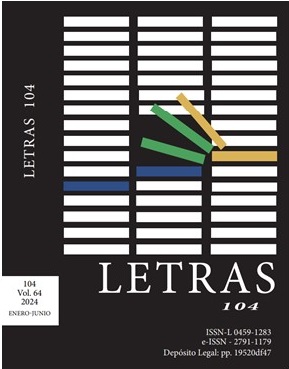Nominal ellipsis in the sociolinguistic corpus of the speech of Maracay, Venezuela
DOI:
https://doi.org/10.56219/letras.v64i104.3030Keywords:
sociolinguistic, correlation, social variables, nominal ellipsisAbstract
In this quantitative, descriptive, and exploratory sociolinguistic study of a variationist nature (Moreno, 2009) we set out to examine the correlation between the social variables sex, age, level of schooling, and socioeconomic level and nominal ellipsis (Casado, 2000) in the speech of Maracay, Venezuela. We employed the Sociolinguistic corpus of the speech of Maracay (Villalobos & Díaz, 2005) and analyzed the frequency of use of nominal ellipsis in three forms: noun, noun plus other complements, and partial, as described by Ticio (2010). We evaluated the relationship between the variables present in the corpus and the frequency of use through Pearson's Correlation Coefficient, calculated with SPSS software. The results indicated that nominal ellipsis is a prevalent cohesive resource in Maracay speech, but its use does not seem to be strongly correlated with the social variables examined in the sample. However, we identify some trends, such as a slight incidence of gender in partial ellipsis and a certain association of age with the rate of noun and partial ellipsis.
Downloads
References
Alarcos, E. (1999). Gramática de la lengua española. Espasa Calpe.
Álvarez-Gayou, J. (2003). Cómo hacer investigación cualitativa: Fundamentos y metodología. Ediciones Culturales Paidós.
Beaugrande, R. de, & Dressler, W. U. (1997). Introducción a la lingüística del texto (1a ed.) Ariel.
Bernárdez, E. (1982). Introducción a la lingüística del texto. Espasa-Calpe.
Calsamiglia, H., y Tusón, A. (1999). Las cosas del decir: Manual de análisis del discurso. Ariel.
Casado, M. (2000). Introducción a la gramática del texto del español (4a ed.). Arco libros.
D´Aquino, G. (2008). El Cambio Lingüístico de Haber Impersonal. Núcleo, 20(25), 103-124.
Eguren, L. (2010). Principios universales y variación paramétrica en la elipsis nominal. Revista lucense de lingüística e literatura, 15, 59-82.
Eguren, L. (2014). Restricciones de la elipsis nominal en español. Revista Española de Lingüística, 38(1), 127-154. DOI: https://doi.org/10.31810/rsel.v38i1.40
Fernández, C. (1998). Variación y prestigio: Estudio sociolingüístico en el Oriente de Cantabrica. Consejo Superior de Investigaciones Científicas.
Gallego, Á. (2016). Elipsis. En J. Gutiérrez-Rexach (Ed.), Enciclopedia de Lingüística Hispánica (p. 13). Routledge. DOI: https://doi.org/10.4324/9781315713441
Galup, Ricardo José. (2014). Pronominalización en el corpus sociolingüístico del habla de Maracay. Letras, 56(90), 76-104. https://lc.cx/hYRxtq
Halliday, M., y Hasan, R. (1976). Cohesion in english. Longman Group Limited.
Hernández, S., Fernández, C., & Baptista, M. del P. (2014). Metodología de la Investigación. McGRAW-HILL / Interamericana Editores.
Hernando, L. A. (2005). La elipsis en el análisis e interpretación de textos. CAUCE, Revista Internacional de Filología y su Didáctica, 28, 169-181.
Jaime, A., y Mestre, E. (2007). Estudio Contrastivo de la elipsis en inglés técnico y literario. Revista de Lingüística y Lenguas Aplicadas, 2(1), 39-46. https://doi.org/10.4995/rlyla.2007.700 DOI: https://doi.org/10.4995/rlyla.2007.700
López, H. (1994). Métodos de investigación lingüística (1a ed). Colegio de España.
Moreno, F. (2009). Principios de sociolingüística y sociología del lenguaje (4a ed.). Ariel.
Moreno, F. (2021). Metodología del «Proyecto para el estudio sociolingüístico del español de España y de América» (PRESEEA). Editorial Universidad de Alcalá. https://doi.org/10.37536/PRESEEA.2021.doc1 DOI: https://doi.org/10.37536/PRESEEA.2021.doc1
Poblete, M. T. (2002). La elipsis en la interacción comunicativa y variación sociolingüística. Estudios filológicos, 37, 117-131. https://doi.org/10.4067/S0071-17132002003700007 DOI: https://doi.org/10.4067/S0071-17132002003700007
Reguera, A. (2008). Metodología de la investigación lingüística: Prácticas de escritura. Brujas.
Silva-Corvalán, C., & Enrique-Arias, A. (2017). Sociolingüística y pragmática del español (2a ed). Georgetown University Press.
Ticio, M. (2010). Relación entre elipsis nominal y foco. Cuadernos de la ALFAL, 1, 54-69.
Villalobos, A., y Díaz, L. (2005). Corpus Sociolingüístico del habla de Maracay. Universidad Pedagógica Experimental Libertador.
Published
How to Cite
Issue
Section
License
Copyright (c) 2024 LETRAS

This work is licensed under a Creative Commons Attribution-NonCommercial-ShareAlike 4.0 International License.
Letras magazine retains the patrimonial rights (copyright) of the published works, which favors and allows their reuse under the license (CC BY - NC - SA 4.0), for which they can be copied, used, disseminated, transmitted and expose publicly, as long as the authorship and original source of its publication (magazine, publisher, URL and DOI of the work) is cited, they are not used for commercial or onerous purposes and the existence and specifications of this use license are mentioned.















